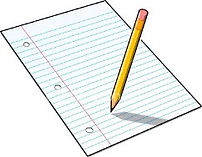
HAND STRENGTHENING
There are well over 25 muscles in your forearm and hand. It may appear that someone has strong hands when they are able to squeeze something really hard. But that's not the whole story. When we look at hand strength, we also need to look at the strength of the small muscles within the hand.
When muscles of the forearm and hand are slow to develop, weakness and incoordination may result. The large muscles of the forearm may overcompensate for weak inner hand muscles. As a result, the child will find ways to hold, pinch and grip small objects in awkward ways.
To help this, we work on in-hand manipulation. In-hand manipulation is the ability to move and position objects within the hand without using the other hand. For this, we work on fine motor skills.

Ways to Practice:
Play dough and/or theraputty – squeeze it, flatten it like a pancake, roll balls (larger ones in the palms and small ones in finger tips) and snakes, pinch between thumb and various fingers, poke it with various fingers, cut with scissors, sculpt with it
Rubber bands – make a rubber band ball or place rubber bands around a can. Can also place rubber bands around all 5 fingers and spread or open/close fingers
Nuts and bolts to screw and unscrew
Model building kits
Paper clip chains
Stack coins or small blocks
Beading, lacing, and/or stitching crafts
Single hole punch – make designs on paper
Clothes pins – place them onto a string, a piece of cardboard, clothing, etc
Small pieces of paper (scrap paper) - Crumple into balls and play game throwing into a bowl
Colored tissue paper - crumple pieces and glue onto construction paper to make art projects
Finger push-ups – place finger tips of your 2 hands together and straighten/bend fingers
Dice games - dice is cupped into both hands so that palms are rounded and dice is sealed inside. Can also try this with beans on beads and shake in hands, trying to keep small items from spilling out
Tongs, tweezers, kids chopsticks – play pick up games with pom poms, cotton balls, beans, or other small items. Can place in a bowl or an empty egg carton. Can also move game board pieces this way
Origami
Wind up toys
Stencils
Pencil games – hold pencil on one end and inchworm crawl your fingers up and down the pencil shaft. Flip the pencil from writing position to erasing position using only one hand
Eye droppers – squeeze/pinch to pick up colored liquids and squirt onto paper or coffee filters
Squirt bottles – spray water color paint on paper to make art (best done outside, hang a large piece of paper so you have a vertical surface to spray). Water plants (indoors and outside)
Snapping fingers
Play piano
Piggy banks – insert coins (can easily make a bank from a yogurt or other plastic tub by cutting a slot in the top)
Feed the ball game – use a razor blade to cut a slit in a tennis ball. Kids can decorate the ball and draw eyes and a nose on the ball so that the slit is the mouth. Squeeze the ball to open the slit, then “feed” it coins, buttons, beans, etc
Stickers – peel and stick
Bubble wrap - pop using only fingers (pinching) or wring it like a towel using 2 hands
Building Toys such as legos, tinker toys, kidknex, zoobs – build and take apart
Mr. Potato Head – build and take apart
Fasteners – practice buttons, snaps, buckles, zippers
Card games - work on shuffling cards, holding the cards spread in one hand, selecting cards from the deck
Stress balls – squeeze and release
Peg boards
Mazes and dot-dot worksheets – these work on visual perceptual skills as well as fine motor control
Board games – there are so many games with small parts that work on fine motor skills, here are just a few: Perfection, Connect four, Hungry hungry hippo, Don’t break the ice, Honey bee tree, Pop the pig, Jenga, Cribbage, Pictionary, Scrabble, Operation, Boggle, Chinese checkers, Cranium games, Trouble, Pick up sticks, Don’t spill the beans, Mancala